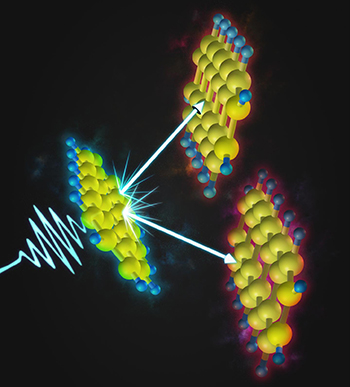
Pentacene molecules convert a single photon into two molecular excitations via the quantum mechanics of singlet fission. Credit: Lawrence W. Chin, David Turban and Alex W. Chin
An international team of scientists has observed how certain organic molecules can split a single photon into two molecular excitations—a quantum-mechanical process that could boost the efficiency of future solar cells (Nature Chem., doi: 10.1038/nchem.2371).
Researchers in the Cavendish Laboratory at the University of Cambridge (U.K.) used ultrafast laser pulses to study the creation of spin-triplet excitons through a process called singlet fission. When certain molecules absorb a photon of light, they transform it into a spin singlet exciton, which breaks into two “triplet” excitons with less energy. Scientists have known that singlet fission happens, but the details of the intermediate stages have remained vague because they are essentially invisible to conventional optical probes.
The group prepared films containing derivatives of pentacene, a polycyclic aromatic hydrocarbon that is known to undergo singlet fission, and subjected the samples to 2-D electronic photon echo spectroscopy. The high time-resolution of this spectroscopic technique—less than 15 fs—allowed the researchers to tease out the intermediate states in the quantum process.
Among their findings, the researchers learned that the vibrational modes of the molecules create brief superposed states of a singlet exciton and a triplet exciton pair. The triplet excitons had been “dark” to previous observational techniques, but the laser spectroscopy revealed their weak signature.
By learning more about this two-for-one process, scientists hope to develop highly efficient solar panels that could create two electron-hole pairs for each absorbed photon.
Scientists from FOM Institute AMOLF (Netherlands), the University of Kiel (Germany) and Lund University (Sweden) also participated in the study.
